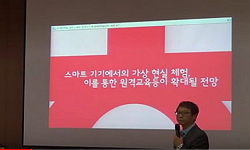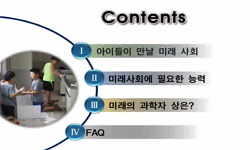This study illuminates how to teach creative dance for non-professional students. According to the findings from this literature and research, an evolution in teaching methods is needed to create a balance between traditional teaching methods and flex...
http://chineseinput.net/에서 pinyin(병음)방식으로 중국어를 변환할 수 있습니다.
변환된 중국어를 복사하여 사용하시면 됩니다.
- 中文 을 입력하시려면 zhongwen을 입력하시고 space를누르시면됩니다.
- 北京 을 입력하시려면 beijing을 입력하시고 space를 누르시면 됩니다.
https://www.riss.kr/link?id=A105905899
-
저자
Jieying Zhu (Artistic Director, Shanghai Dance Theatre)

- 발행기관
- 학술지명
- 권호사항
-
발행연도
2018
-
작성언어
English
- 주제어
-
등재정보
KCI등재
-
자료형태
학술저널
- 발행기관 URL
-
수록면
1-9(9쪽)
-
KCI 피인용횟수
0
- DOI식별코드
- 제공처
- 소장기관
-
0
상세조회 -
0
다운로드
부가정보
다국어 초록 (Multilingual Abstract)
This study illuminates how to teach creative dance for non-professional students. According to the findings from this literature and research, an evolution in teaching methods is needed to create a balance between traditional teaching methods and flexible teaching methods in the dance classroom. An instructor must also be able to utilize these teachings realistically in class. Becoming a supportive teacher by using positive language in a creative class is one of the most important ways that a great number of students can be inspired and motivated. A teacher’s flexibility in utilizing various teaching methods is also an important quality that the learning environment in a creative dance class should begin to include. This study indicates that teaching creative dance for non-professional students must go beyond traditional and unitary teaching methods and instead an instructor should learn to be geared toward utilizing a number of teaching strategies at each appropriate situation for each student.
참고문헌 (Reference)
1 Atencio, M., "‘Ballet it’s too whitey‘ : discursive hierarchies of high school dance spaces and the constitution of embodied feminine subjectivities" 21 (21): 31-46, 2009
2 BenZion, G., "communication in classical ballet pedagogy" 83 (83): 5-6, 2012
3 Cortese, A., "Working memory for ballet moves and spatial locations in professional ballet dancers" 24 (24): 266-286, 2010
4 Hagood, T. K., "Values and voice in dance education: The merit of fostering tradition, experiment, diversity, and change in our pedagogy" 108 (108): 33-37, 2006
5 Perry, G., "This story wants to be danced: Creative writing, dance, convergence and confluence" 4 (4): 135-140, 2007
6 Ingrid Pramling Samuelsson, "The art of teaching children the arts: music, dance and poetry with children aged 2–8 years old" Informa UK Limited 17 (17): 119-135, 2009
7 Lakes, R., "The Messages behind the Methods: The Authoritarian Pedagogical Legacy in Western Concert Dance Technique Training and Rehearsals" 106 (106): 3-, 2005
8 Penniment, K. J., "Perfectionism and learning experiences in dance class as risk factors for eating disorders in dancers" 20 (20): 13-22, 2012
9 Leijen, Ä., "Pedagogy before technology : what should an ICT intervention facilitate in practical dance classes?" 13 (13): 219-231, 2008
10 Radell, S., "My body and its reflection : a case study of eight dance students and the mirror in the ballet classroom" 15 (15): 161-178, 2014
1 Atencio, M., "‘Ballet it’s too whitey‘ : discursive hierarchies of high school dance spaces and the constitution of embodied feminine subjectivities" 21 (21): 31-46, 2009
2 BenZion, G., "communication in classical ballet pedagogy" 83 (83): 5-6, 2012
3 Cortese, A., "Working memory for ballet moves and spatial locations in professional ballet dancers" 24 (24): 266-286, 2010
4 Hagood, T. K., "Values and voice in dance education: The merit of fostering tradition, experiment, diversity, and change in our pedagogy" 108 (108): 33-37, 2006
5 Perry, G., "This story wants to be danced: Creative writing, dance, convergence and confluence" 4 (4): 135-140, 2007
6 Ingrid Pramling Samuelsson, "The art of teaching children the arts: music, dance and poetry with children aged 2–8 years old" Informa UK Limited 17 (17): 119-135, 2009
7 Lakes, R., "The Messages behind the Methods: The Authoritarian Pedagogical Legacy in Western Concert Dance Technique Training and Rehearsals" 106 (106): 3-, 2005
8 Penniment, K. J., "Perfectionism and learning experiences in dance class as risk factors for eating disorders in dancers" 20 (20): 13-22, 2012
9 Leijen, Ä., "Pedagogy before technology : what should an ICT intervention facilitate in practical dance classes?" 13 (13): 219-231, 2008
10 Radell, S., "My body and its reflection : a case study of eight dance students and the mirror in the ballet classroom" 15 (15): 161-178, 2014
11 Whittier, C., "Laban movement analysis approach to classical ballet pedagogy" 6 (6): 124-132, 2006
12 Carroll, Noel, "Kinesthetic understanding and appreciation in dance" 71 (71): 177-186, 2013
13 Schwartz, P., "Creativity and dance: Implications for pedagogy and policy" 95 (95): 8-, 1993
14 Pickard, A., "Ballet body belief: perceptions of an ideal ballet body from young ballet dancers" 14 (14): 3-19, 2013
동일학술지(권/호) 다른 논문
-
Interfaces between Physical and Virtual Bodies in Merce Cunningham’s BIPED
- 한국무용예술학회
- 한석진
- 2018
- KCI등재
-
The Placelessness of Korean Folk Dance -Focusing on Public Stadiums in the 1970s’ Korea-
- 한국무용예술학회
- 윤지현
- 2018
- KCI등재
-
The Inquiry of Dance Program as a Cultural Education -Focusing on Korean Culture-
- 한국무용예술학회
- 윤지은
- 2018
- KCI등재
-
- 한국무용예술학회
- 소혜진
- 2018
- KCI등재
분석정보
인용정보 인용지수 설명보기
학술지 이력
| 연월일 | 이력구분 | 이력상세 | 등재구분 |
|---|---|---|---|
| 2027 | 평가예정 | 재인증평가 신청대상 (재인증) | |
| 2021-01-01 | 평가 | 등재학술지 유지 (재인증) |  |
| 2018-01-01 | 평가 | 등재학술지 유지 (등재유지) |  |
| 2015-01-01 | 평가 | 등재학술지 유지 (등재유지) |  |
| 2014-10-22 | 학회명변경 | 영문명 : 미등록 -> The Korean Society for Dance Studies |  |
| 2011-01-01 | 평가 | 등재학술지 선정 (등재후보2차) |  |
| 2010-01-01 | 평가 | 등재후보 1차 PASS (등재후보1차) |  |
| 2009-01-01 | 평가 | 등재후보 1차 FAIL (등재후보2차) |  |
| 2008-01-01 | 평가 | 등재후보 1차 PASS (등재후보1차) |  |
| 2007-01-01 | 평가 | 등재후보학술지 유지 (등재후보2차) |  |
| 2006-01-01 | 평가 | 등재후보 1차 PASS (등재후보1차) |  |
| 2004-01-01 | 평가 | 등재후보학술지 선정 (신규평가) |  |
학술지 인용정보
| 기준연도 | WOS-KCI 통합IF(2년) | KCIF(2년) | KCIF(3년) |
|---|---|---|---|
| 2016 | 0.51 | 0.51 | 0.53 |
| KCIF(4년) | KCIF(5년) | 중심성지수(3년) | 즉시성지수 |
| 0.51 | 0.52 | 0.698 | 0.29 |




 KCI
KCI KISS
KISS







